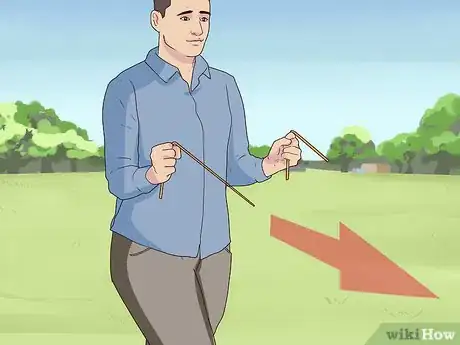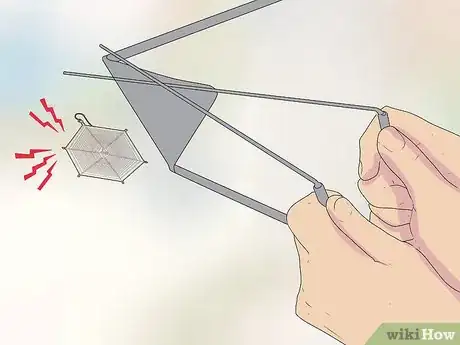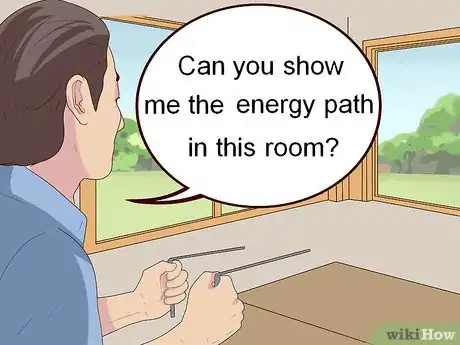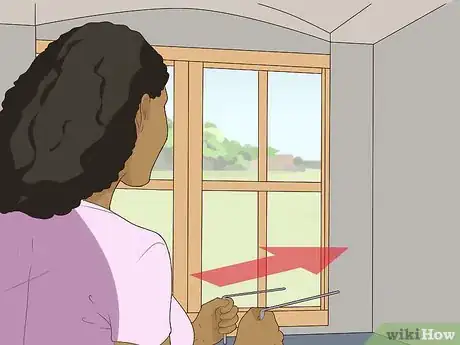This article was co-authored by Jennifer McVey, Cht. Jennifer McVey is a Spiritualist, Seer, and the Spiritual Director of Spiritual Answers and Solutions. With more than 22 years of experience, she specializes in manifesting, ghosts and spirit attachments, hypnotherapy, channeling, and spiritually based life coaching. Jennifer has also published 13 Affirmation Image and six Word Search Puzzle books in spirituality and self-help and has produced over 600 audio sessions.
wikiHow marks an article as reader-approved once it receives enough positive feedback. In this case, 93% of readers who voted found the article helpful, earning it our reader-approved status.
This article has been viewed 749,606 times.
Before technology was developed that would allow us to "see" into the ground, people depended on dowsing (also known as divining or water witching) to find water wells, metals, gemstones, and even missing people and unmarked graves. Although dowsing has never been scientifically proven to work in a controlled setting, the practice remains popular in many parts of the world.[1] You can use dowsing or divining rods by learning how to hold the rods properly. You can then use the rods to find water, locate lost objects, or determine the energy of a room or area.
Steps
Holding the Rods Properly
-
1Find dowsing or divining rods. You can use natural items as dowsing or divining rods, such as tree branches or sticks. Often, diviners use forked sticks from trees such as willow, peach, and witch hazel. Look for a stick that has a fork with branches of equal length on either end of the fork.[2]
- If you do not want to use a forked stick, you can use coat hanger, two wire rods, or a pendulum as a dowsing rod. Cut the coat hanger so you have two pieces of wire that are the same length and extend at least one to two feet. You can also use two wire rods of equal length or a pendulum made especially for dowsing from New Age stores or online.
- Some divining rods have an L-shape on each end, where the wire extends downward to form an L-shape. You can find L-shaped rods online or at New Age stores.
-
2Hold the rods an arm’s length away from your body. You should then hold the rods in each hand at an arm’s length away from your body. Position the rods so they rest flat over your index fingers and let the butt of the handles rest in the heel of your hands. Hold the handles firm enough but do not grip them too tightly, as the rods need to be able to float freely to work.
- Hold the rods about 9 inches (23 cm) apart so they do not cross or collide. You may want to practice holding the rods in your hands a few times to get the hang of it.
- If you are using one forked stick, you should hold it an arm's length away from your body. Make sure you hold the stick lightly so it can float freely in your hand.
Advertisement -
3Keep the rods steady and straight as you walk. Once you understand how to hold the rods properly, you should practice walking and moving around while holding the rods. Make sure you keep the rods steady and straight as you walk so they are parallel to the ground.
- Hold the rods at arm’s length and walk slowly back and forth across the room. Do not let the rod end tip upward or downward as you move as you do not want to move the rods unintentionally with the force of your body or your arms.
Finding Bodies of Water
-
1Hold the rods steady in your hands. Start by holding the dowsing or divining rods steady and straight in your hands, at an arm’s length from your body. Make sure the rod ends are not tipped upward or downward. You should also make sure the rods are 9 inches (22.9 cm) from each other.[3] [4]
- If you are using a Y-shaped rod, the rod should be pointed upward at a 45 degree angle. This will ensure you are able to get a good reading of the area.
- If you are using L-shaped rods, you should be holding the bottom of the “L”, and that the top of it is should point forward.
-
2Walk over the area with the rods. Often, water dowsers are called to locate water in a certain area, such as a rural or suburban community. You should hold the rods properly and walk back and forth slowly over the area that you are testing for water. Make sure you hold the rods lightly but with some grip so they do not roll or shift in your hands as you walk.[5] [6]
-
3Wait for the rods to cross or move. Once the rods detect water, the butt end of the stick should rotate or be pulled downward. The rods may also cross over each other when you stand in a certain spot in the area, indicating there may be water under the surface.[7] [8]
- It may also help to visualize the water under the earth as you walk over the area with the rods. You may picture a stream or body of water in your mind as you hold the rods to help let the rods know what you are looking for.[9]
Locating Lost Objects
-
1Relax and visualize the lost object. You can use the dowsing rods to locate objects or items you have lost, such as jewellery. Start by holding the rods properly in your hands. Then, relax and close your eyes. Visualize the object you have lost in your mind.
- You may want to take a few deep breaths to calm down and relax. Focus your mind on the lost object and try to channel that focus into the divining rods.
-
2Ask the rods to lead you to the object. You may ask the rods out loud or internally. You may say, “Where is the object I have lost?” or “Find the object.” This will project your intent onto the rods.
-
3Let the rods direct you to the object. You should then hold the rods steady and straight in your hands and let them direct you. Do not resist any pulls or tugs you feel on the rods. You should walk in the direction the rods seem to be leading you to. Eventually, the rods may lead you to the lost object.
Determining the Energy of an Area or Room
-
1Visualize the energy in the area or room. You can use divining rods to test the amount of positive and negative energy in an area or a room, known as the “Chi” of the room. You may decide to test the energy levels in your home, your office, or even your garden. Do this by entering the room holding the rods. Then, close your eyes and try to visualize the “Chi” energy in the room. Try to picture an energy path that flows throughout the entire room or area. Don't worry if you are not able to do this, as the rods will help you determine the energy flow or path.
- The divining rods can help you trace this flow of “Chi”. You can then make adjustments to the set up of the room or space so the “Chi” can flow more freely. This could then make the space feel more positive and uplifting. A room with good energy will have an even amount of “Chi” flowing throughout the room.
-
2Ask the rods to lead you to the energy path. You can do this verbally or internally. You may say, “Can you show me the energy path in this room?” or “Show me how the energy flows in this space.” This will allow you to communicate your intent to the rods.
-
3Let the rods lead you to these areas. Follow any pulls or tugs on the rod, moving in a path. You should try to walk in every area of the room to determine how it fits within the energy flow of the room. The rods may help to guide you to where the “Chi” is flowing well in the room and where it is not flowing at all.
- If you notice you are walking in circles as you are lead by the rods, you may then to reposition the rods in your hands and repeat your intention to them again. Ideally, the rods should create a path through the room, touching each area of the room. Any areas that are skipped may need to be adjusted by moving furniture or items in the area to improve the flow of energy.
Community Q&A
-
QuestionHow do I read an answer?
 Community AnswerConcentrate -- for concentration you need to take interest in the subject. For developing interest, you need to have curiosity for the subject and for curiosity, you need to be present in the moment. To be in the present moment, you need to live in present with openness.
Community AnswerConcentrate -- for concentration you need to take interest in the subject. For developing interest, you need to have curiosity for the subject and for curiosity, you need to be present in the moment. To be in the present moment, you need to live in present with openness. -
QuestionWhat types of metals are accepted?
 Community AnswerThe wire can be brass, copper, steel – any sturdy but bendable material. Copper and brass are more popular, as they do not rust.
Community AnswerThe wire can be brass, copper, steel – any sturdy but bendable material. Copper and brass are more popular, as they do not rust. -
QuestionShould I wear shoes to insulate my body?
 Community AnswerNo. You won't be electrified, as that is just a myth. However, as you'll likely be outdoors, you may want to wear them to protect your feet.
Community AnswerNo. You won't be electrified, as that is just a myth. However, as you'll likely be outdoors, you may want to wear them to protect your feet.
References
- ↑ http://geology.com/articles/water-dowsing/
- ↑ http://water.usgs.gov/edu/dowsing.html
- ↑ http://water.usgs.gov/edu/dowsing.html
- ↑ http://www.motherearthnews.com/homesteading-and-livestock/divining-rod-zmaz70ndzgoe.aspx
- ↑ http://water.usgs.gov/edu/dowsing.html
- ↑ http://www.motherearthnews.com/homesteading-and-livestock/divining-rod-zmaz70ndzgoe.aspx
- ↑ http://water.usgs.gov/edu/dowsing.html
- ↑ http://www.motherearthnews.com/homesteading-and-livestock/divining-rod-zmaz70ndzgoe.aspx
- ↑ http://www.telegraph.co.uk/sponsored/culture/water-diviner/11464210/what-is-water-divining.html
About This Article
To use dowsing rods to locate water, locate a forked branch or cut a coat hanger so you have 2 wires of equal length. Next, hold the rods at arm's length while gripping them lightly. To assist the rods in locating the water, try to visualize in your mind what you're looking for, like a stream. Then, walk slowly over the area you're testing for water and wait for the rods to move or point downwards. Alternatively, you may see the rods cross over if they detect water. To learn how to use dowsing rods to determine the energy of a room, read on!










































































